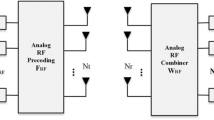Abstract
Hybrid Precoding widely used in millimeter-wave massive Multi Input Multi Output systems to reduce the number of radio frequency (RF) chains. Nevertheless, the conventional hybrid precoding (HP) strategy, which uses a singular value decomposition (SVD) method, requires complicated bit assignment in order to balance the signal-to-noise ratio of numerous sub-channels. This approach leads to a significant amount of coding and decoding complexity in practical systems. A new decomposition technique called Geometric mean decomposition hybrid precoding (GMDHP) is used to get around the difficult bit allocation procedure in singular value decomposition based hybrid precoding (SVD-HP).Bit assignment becomes simpler because all sub channels in Geometric Mean Decomposition Based Hybrid Precoding have equal SNRs. In terms of bit allocation, Geometric Mean Decomposition Based Hybrid Precoding is still more difficult than Singular Value Decomposition Based Precoding, but the design complexity is reduced. The development of analog and digital precoders is accountable for this elevated level of design complexity. The orthogonal matching pursuit (OMP) method is the foundation of the analogue precoder architecture, which is very non-convex in nature. This research proposed two different precoding methods, SVD-HP and GMD-HP, and evaluated their performance against spatially sparse precoding and analogue beam steering.The simulation results of SNR vs. SE for the proposed Matrix Decomposition-based precoding approaches are compared.







Similar content being viewed by others
Data Availability
Data sharing not applicable to this article as no datasets were generated during the current study.
Code Availability
Software application.
References
Mumtaz, S., Rodriguez, J., & Dai, L. (2016). MmWave Massive MIMO: a Paradigm for 5G. Academic Press.
Feng, W., Wang, Y., Lin, D., Ge, N., Lu, J., & Li, S. (2017). When mmwave communications meet network densification: A scalable interference coordination perspective. IEEE Journal on Selected Areas in Communications, 35(7), 1459–1471.
Jeyakumar, P., Malar, E., Idnani, N., & Muthuchidambaranathan, P. (2021). Large antenna array with hybrid beamforming system for 5g outdoor mobile broadband communication deployments. Wireless Personal Communications, 120(3), 2001–2027.
Alkhateeb, A., Leus, G., & Heath, R. W. (2015). Limited feedback hybrid precoding for multi-user millimeter wave systems. IEEE Transactions on Wireless Communications, 14(11), 6481–6494.
Park, S., Alkhateeb, A., & Heath, R. W. (2017). Dynamic subarrays for hybrid precoding in wideband mmwave mimo systems. IEEE Transactions on Wireless Communications, 16(5), 2907–2920.
Kong, L., Han, S., & Yang, C. (2018). Hybrid precoding with rate and coverage constraints for wideband massive mimo systems. IEEE Transactions on Wireless communications, 17(7), 4634–4647.
El Ayach, O., Rajagopal, S., Abu-Surra, S., Pi, Z., & Heath, R. W. (2014). Spatially sparse precoding in millimeter wave mimo systems. IEEE Transactions on Wireless Communications, 13(3), 1499–1513.
Gao, Z., Dai, L., Mi, D., Wang, Z., Imran, M. A., & Shakir, M. Z. (2015). Mmwave massive-mimo-based wireless backhaul for the 5g ultra-dense network. IEEE Wireless Communications, 22(5), 13–21.
Xu, Z., Han, S., Pan, Z., & Chih-Lin, I. (2015). Alternating beamforming methods for hybrid analog and digital mimo transmission. In 2015 IEEE International Conference on Communications (ICC), pp. 1595–1600. IEEE
Zi, R., Ge, X., Thompson, J., Wang, C.-X., Wang, H., & Han, T. (2016). Energy efficiency optimization of 5g radio frequency chain systems. IEEE Journal on Selected Areas in Communications, 34(4), 758–771.
Gao, X., Dai, L., Han, S., Chih-Lin, I., & Heath, R. W. (2016). Energy-efficient hybrid analog and digital precoding for mmwave mimo systems with large antenna arrays. IEEE Journal on Selected Areas in Communications, 34(4), 998–1009.
He, S., Qi, C., Wu, Y., & Huang, Y. (2016). Energy-efficient transceiver design for hybrid sub-array architecture mimo systems. IEEE Access, 4, 9895–9905.
Xiao, Z., Xia, P., & Xia, X.-G. (2017). Channel estimation and hybrid precoding for millimeter-wave mimo systems: A low-complexity overall solution. IEEE Access, 5, 16100–16110.
Chao, C.-L., Tsai, S.-H., & Hsu, T.-Y. (2011). Bit allocation schemes for mimo equal gain precoding. IEEE Transactions on Wireless Communications, 10(5), 1345–1350.
Chen, C.-E., Tsai, Y.-C., & Yang, C.-H. (2014). An iterative geometric mean decomposition algorithm for mimo communications systems. IEEE Transactions on Wireless Communications, 14(1), 343–352.
Xie, T., Dai, L., Gao, X., Shakir, M. Z., & Li, J. (2018). Geometric mean decomposition based hybrid precoding for millimeter-wave massive mimo. China Communications, 15(5), 229–238.
Gu, S., Liu, X., & Chen, X. (2017). Zero-forcing hybrid precoding based on qr-decomposition in millimeter wave systems. In 2017 IEEE 17th International Conference on Communication Technology (ICCT), pp. 112–116. IEEE
Forenza, A., Love, D. J., & Heath, R. W. (2007). Simplified spatial correlation models for clustered mimo channels with different array configurations. IEEE Transactions on Vehicular Technology, 56(4), 1924–1934.
Chen, C.-E., Tsai, Y.-C., & Yang, C.-H. (2014). An iterative geometric mean decomposition algorithm for mimo communications systems. IEEE Transactions on Wireless Communications, 14(1), 343–352.
Funding
The authors received no financial support for the research work.
Author information
Authors and Affiliations
Corresponding author
Ethics declarations
Conflict of interest
The authors declare that they have no conflict of interest.
Additional information
Publisher's Note
Springer Nature remains neutral with regard to jurisdictional claims in published maps and institutional affiliations.
Rights and permissions
Springer Nature or its licensor (e.g. a society or other partner) holds exclusive rights to this article under a publishing agreement with the author(s) or other rightsholder(s); author self-archiving of the accepted manuscript version of this article is solely governed by the terms of such publishing agreement and applicable law.
About this article
Cite this article
Thurpati, S., Muthuchidambaranathan, P. Hybrid Precoder Design Based on mm-Wave MIMO System with GMD Method. Wireless Pers Commun 129, 2891–2907 (2023). https://doi.org/10.1007/s11277-023-10263-0
Accepted:
Published:
Issue Date:
DOI: https://doi.org/10.1007/s11277-023-10263-0




